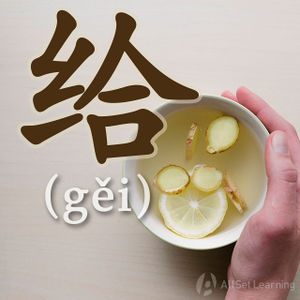Difference between revisions of "Verbs preceded by "gei""
| Line 1: | Line 1: | ||
{{Grammar Box}} | {{Grammar Box}} | ||
| + | |||
| + | Chinese speakers use 给 (gěi) in some interesting ways, similar to how English speakers use "to give". | ||
| + | |||
== Structure 1 == | == Structure 1 == | ||
| Line 14: | Line 17: | ||
<div class="liju"> | <div class="liju"> | ||
| − | * 我 <em>给</em> <strong>他</strong> 打 电话。 | + | * 我 <em>给</em> <strong>他</strong> 打 电话。<span class="trans">I give him a phone call. (Literally: I give him hit phone.)</span> |
| − | * 请 <em>给</em> <strong>我</strong> 回复。 | + | * 请 <em>给</em> <strong>我</strong> 回复。<span class="trans">Please give me a reply.</span> |
| − | * 你 妈妈 每天 都 <em>给</em> <strong>你</strong> 做饭 吗? | + | * 你 妈妈 每天 都 <em>给</em> <strong>你</strong> 做饭 吗?<span class="trans">Does your mama cook for you every day? (Literally: Your mama everyday gives you cook food?</span> |
| − | * 我 想 <em>给</em> <strong>你</strong> 一个 好 东西。 | + | * 我 想 <em>给</em> <strong>你</strong> 一个 好 东西。<span class="trans">I want to give you something good.</span> |
</div> | </div> | ||
| Line 23: | Line 26: | ||
== Structure 2 == | == Structure 2 == | ||
| − | The meaning is the same with | + | The meaning is the same with Structure 1 above, except that there is a limit to the verbs you can use. The verbs often used are "打电话、回邮件、发邮件、送礼物、传文件" |
| + | |||
| + | . 但是对使用的动词有限制,经常用的是“打电话、回邮件、发邮件、送礼物、传文件”。 | ||
<div class="jiegou"> | <div class="jiegou"> | ||
Revision as of 02:00, 31 January 2013
-
Level
-
Similar to
-
Used for
-
Keywords
Chinese speakers use 给 (gěi) in some interesting ways, similar to how English speakers use "to give".
Contents
Structure 1
The word 给 (gěi) literally means "to give", but is frequently used in Chinese to indicate the target of a verb. The target is who or what the verb is aimed or directed at. There are two structures for this:
Subject + 给 + Target + Verb + Object
Examples
- 我 给 他 打 电话。I give him a phone call. (Literally: I give him hit phone.)
- 请 给 我 回复。Please give me a reply.
- 你 妈妈 每天 都 给 你 做饭 吗?Does your mama cook for you every day? (Literally: Your mama everyday gives you cook food?
- 我 想 给 你 一个 好 东西。I want to give you something good.
Structure 2
The meaning is the same with Structure 1 above, except that there is a limit to the verbs you can use. The verbs often used are "打电话、回邮件、发邮件、送礼物、传文件"
. 但是对使用的动词有限制,经常用的是“打电话、回邮件、发邮件、送礼物、传文件”。
Subject + Verb + Object + 给 + Target
Examples
- 你 打 电话 给 他。
- 我 会 发 邮件给 他。
- 他 昨天 送 花 给 我 了。



